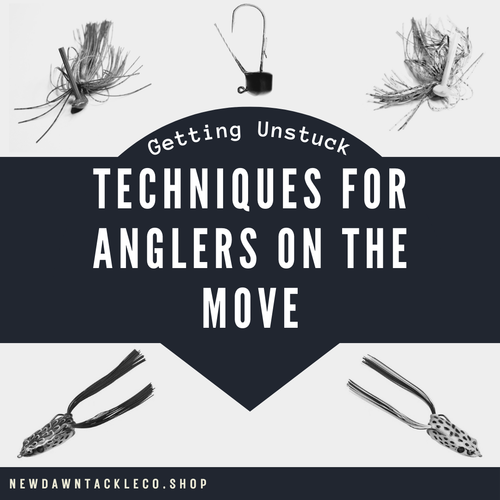
Getting Unstuck: Techniques for Anglers on the Move
Neil ColicchioShare
The first trip on a new body of water is a sensation rivaled only by that of catching a fish. The uncertainty of what lies beneath the surface, the anticipation of finding a new personal best—it’s what keeps us anglers coming back for more. But as any seasoned fisherman knows, with the excitement of new waters also comes the inevitable frustration of getting lures and hooks stuck in unseen obstacles.
Every bump, scrape, and snag is a conversation with the water itself. With each stray clump of algae and each tattered blade of grass, the underwater world is unveiled. The rocks, logs, and ledges tell the story of past storms, the silent work of beavers, and the remnants of farms, mill towns, and rock quarries lost to time. More importantly, they reveal changes in depth, lighting, current, and surface that hold the keys to finding your target species.
That log branch sticking out of the water is an excellent place to begin searching for vertical structure below, a positive sign for those in search of crappie. That new trailer - the extra blade of grass hanging off the back of your lure - is a clue that a grass bed is nearby. Fishing a bit higher in the water column might unlock a big bass bite. While we all dream of a snagless day and a trip without any lost lures, learning to work with a disadvantage will inevitably yield more fish and a happier day on the water.
The Frustration of a Snag and How to Beat It
Getting snagged is almost inevitable for those of us who love to cast near structures where big fish like to hide. But before you resign yourself to losing another lure or cutting your line, there are several techniques you can use to free your gear and get back to fishing.
1. A Controlled Retrieve
It's no secret that casting takes practice with any style of rod and reel. One windy day can easily send a lure sailing into a tree. When this happens, let the lure sit until it stops swinging. If you've avoided wrapping it around the branch, there's a very good chance that you can retrieve it without snagging if you go slowly.
Consider how a snake weaves through a tree canopy, gliding between and over the branches. It might wrap its tail around a branch for grip and balance, but never when it's on the move. Similarly, the idea here is to pause any time the lure starts swinging and looking like it will wrap. Reel slowly up and over the obstacle, pausing each time you've come to the other side. Wait for the pendulum motion of your lure to stop before reeling slowly over the next branch.
Note: If your lure still snags with this technique, try rattling it loose rather than pulling deeper into the snag.
2. The Gentle Tug-and-Release
When you first feel your lure or hook snag, resist the urge to yank hard. Instead, try a series of gentle tugs in different directions. Often, the hook is only lightly caught, and a change in angle can be enough to free it. Start by moving your rod tip to the opposite side of where you think the snag is, then gently pull. If that doesn’t work, lower the rod tip and give a slight upward pull. This method is particularly effective when fishing in rocky areas where the hook might be wedged between stones.
Note: This technique can be especially effective when fishing braided line, as the line’s lack of stretch gives you more direct control.
3. The Bow-and-Arrow Trick
First, reel in the slack so there’s tension on the line. Then, point your rod tip directly at the snag and pull back on the line, slightly above the reel, as if you were drawing a bow. Release the line quickly, allowing the tension to snap the lure free. This method uses the elasticity of the line to “pop” the lure out of the snag.
Note: The sudden release of tension is supposed to dislodge the hook. I've never had success with this technique, but many on YouTube and Instagram report success with this method. Proceed at your own risk.
4. The Paddle Assist
For anglers fishing from a canoe or kayak, this technique can be particularly effective. First, position yourself over the snag or as close as you can reasonably get while maintaining a good balance. Using the blade of your paddle, bump the hook or lure away from the snag. Be careful to avoid applying any tension or friction directly to your line.
Note: Shore anglers can use a similar technique with a long stick or hiking pole. If the hook is lodged in a low-hanging branch, a stick can also aid in pulling the branch closer for easier retrieval.
Snag Prevention
While the techniques above can save many lures, having the right gear can also make a big difference in preventing snags in the first place.
Weedless Hooks and Lures:
With heavy weed guards and low-profile hooks, weedless tackle makes it easier to glide through heavy cover and glance off of structures that might present an obstacle for standard options.
Braided Line:
Braided line offers more sensitivity and tactile feedback that may help anglers to anticipate a snag. In addition, it minimizes stretch, allowing for a more controlled retrieve.
Stay Prepared and Keep Exploring
With a bit of patience and the proper techniques, even the gnarliest snag can become a valuable tool for the astute angler. Make a note of where and how the hook got stuck. Practice reading the debris that comes back when the snag is released. Dead and decaying plants today could yield lush grass beds and thick mats of lilypads in seasons to come.
And if you’re looking for more tips on how to improve your fishing game, be sure to check out the fishing tips and tutorials section of the blog.
Snags are an inevitable part of fishing, but they don’t have to ruin your day. With these techniques, you can turn a frustrating moment into a quick recovery and get back to the fun part—catching fish. So, next time you find yourself stuck, remember these tips and tackle the challenge head-on. Tight lines and happy fishing!
Neil Colicchio
Owner, New Dawn Tackle Co.



